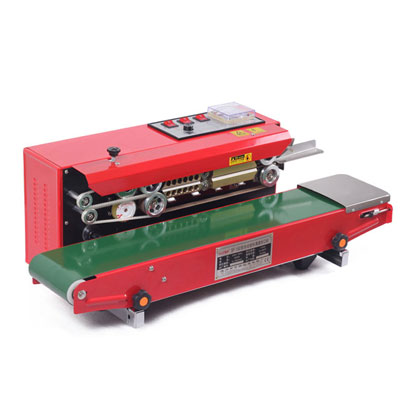The working principle of a plastic bag sealer is relatively simple. It utilizes heat to melt the plastic and form a secure seal, preventing the contents from spilling out and protecting them from air, moisture, and contaminants.

A plastic bag heat sealer is a simple heater that, when pressed and applied to a thermoplastic bag, seals the bag together using a combination of pressure and melting. The two plastic parts are brought together and pressed against one another and heated.
Heating Element: The heating element generates the necessary heat to melt the plastic material and create the seal. It can be made of metal or ceramic materials that can withstand high temperatures.
Sealing Jaws: The sealing jaws are two parallel bars or plates that come together when the sealer is activated. They apply pressure and heat to the plastic, creating a seal along the desired area.
Controls: Plastic sealers may have control knobs, buttons, or digital displays to adjust the temperature, sealing time, and other parameters. These controls allow users to customize the sealing process based on the type and thickness of the plastic material being sealed.
Safety Features: Some plastic sealers are equipped with safety features such as thermal cut-off mechanisms or insulated handles to prevent overheating or accidental burns.
Plastic sealers are typically portable and easy to use, making them suitable for both industrial and household applications. They provide a cost-effective and efficient way to package and seal various items, ensuring their freshness, integrity, and protection during storage or transportation.
Preparation: The plastic bag sealer is first plugged into an electrical outlet and allowed to warm up for a few seconds or minutes, depending on the model.
Bag Placement: The open end of the plastic bag is then placed between the sealing jaws of the sealer. The sealing jaws are typically made of metal or ceramic materials that can withstand high temperatures.
Sealing: The user then presses down on the sealing arm or lever, which activates the heating element inside the sealing jaws. The heat melts the plastic material, creating a tight seal along the length of the bag. Some sealers may also have a cutter that cuts off any excess material beyond the seal.
Cooling: After the seal is formed, the sealing jaws are released, and the bag is allowed to cool for a few seconds. This ensures that the seal solidifies and becomes more durable.
Repeat: The process is then repeated for any additional bags that need to be sealed.
It's worth noting that different types of plastic bag sealers may have variations in their working principles. For example, some sealers may use a vacuum mechanism to remove air from the bag before sealing, while others may use a different type of heating element or sealing mechanism. However, the basic principle of using heat to melt the plastic material and create a seal remains the same.
No. 15, Gangfu Rd., Airport New Area, Wenzhou,China
+86-135 8769 2702 +86-139 5773 7637
+86-577-88998813
+86-577-88996613

GET A QUOTE